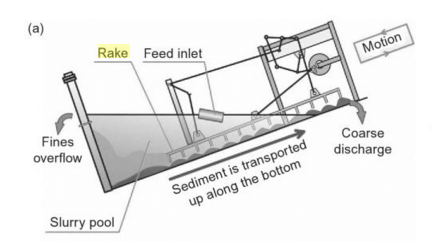Hydrocyclone Feed Pump and Pressure

For a hydrocyclone to work at peak efficiency the volume of slurry and the feed pump delivery pressure must remain constant. If the cyclone feed pump is allowed to SURGE, the up and down pressure will cause poor separation at the point of high and low operating pressure. There is a cycle to a surging pump […]
Hydrocyclones Suppliers

If you are looking for an affordable Hydrocyclones Suppliers, contact us.
Troubleshooting Hydrocyclones

Here is a simple Table for Troubleshooting Hydrocyclones. Other Hydrocyclone Troubleshooting Tips: Underflow is too wet Apex is too large Vacuum control valve is open too far Inlet pressure is too low Pump is cavitating Underflow is too dry (cone is plugging) Apex is too small. Vacuum control valve is closed too far. Percent solids is too […]
Hydrocyclone Working Principle

The third type of classification used in mining is the Hydrocyclone, commonly called a Cyclone. Unlike the others it has no moving parts and is worked in conjunction of another piece of equipment, a pump. To understand the Hydrocyclone Working Principle we must first know its components. Beginning at the top, there is the OVERFLOW […]
Rake Classifier Suppliers

If you are looking for an affordable screw classifier manufacturer, contact us.
Screw Classifier Manufacturers

Spiral Classifiers provide greater sand raking capacity, have improved gear reducer and drive arrangement. Available in three degrees of submergence, in three tank styles, single, double or triple pitch spiral, with either manual or hydraulic lifting device. If you are looking for an affordable screw classifier manufacturer, contact us.
Spiral Classifier Manufacturers

If you are looking for affordable Spiral Classifier Manufacturers, contact us.
Screw Classifier Suppliers

If you are looking for an affordable screw classifier supplier, contact us.
Spiral Classifier for Mineral Processing

In Mineral Processing, the SPIRAL Classifier on the other hand is rotated through the ore. It doesn’t lift out of the slurry but is revolved through it. The direction of rotation causes the slurry to be pulled up the inclined bed of the classifier in much the same manner as the rakes do. As it […]
Rake Classifier

Let me describe a cycle of the Rake Classifier arm to you. The arm, with a series of rakes along its length, drops into the flow of slurry and is pulled upwards. Some of the fine material will flow over, the top of the rake. The rest will be pulled along with the coarser heavier […]
